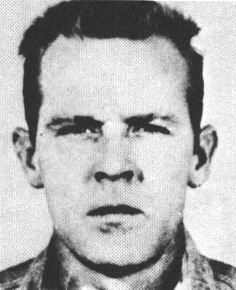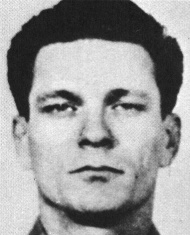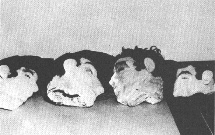ESCAPE NO. 13
11 June 1962, Monday
 |
Name: Clarence Anglin
Age: 31
|
 |
Name: John William Anglin
Age: 32
|
 |
Name: Frank Lee Morris
Age: 35
|
At 9:30, Monday night, convicts Frank Morris and brothers John and Clarence Anglin were counted in the last head count of the night. The lights were subdued and the guard in the gun gallery retired for the evening.
 The
three convicts then placed life-life dummy heads, made from plaster and
real hair, and pillows imitating their bodies into their cots. Then they
crawled through the mesh-covered air vents in the back of their cells.
They had managed to widen the opening of the vents by using mess-hall spoons
and knives to chip away the concrete. To conceal their presumably months-long
effort, they had created fake vent covers from painted plasterboard which
were hidden by accordion cases (Morris) or towels (Anglins).
The
three convicts then placed life-life dummy heads, made from plaster and
real hair, and pillows imitating their bodies into their cots. Then they
crawled through the mesh-covered air vents in the back of their cells.
They had managed to widen the opening of the vents by using mess-hall spoons
and knives to chip away the concrete. To conceal their presumably months-long
effort, they had created fake vent covers from painted plasterboard which
were hidden by accordion cases (Morris) or towels (Anglins).
The three then climbed from their cells, which were located at the bottom tier of B-block, thirty feet up the pipes in the utility corridor behind the cell-block to a ventilator opening at the top. By this evening, they had already removed the rivets from the ventilator cover using a home-made drill converted from an electric fan, and managed to bend the 12-inch crossbar using a crowbar. Taking along life-preservers and an inflatable raft made from raincoats, plywood paddles, and personal effects, they “popped” the cover off the ventilator shaft.
The convicts then climbed onto the roof, and made their way over to a kitchen exhaust pipe at the north end of the roof without being detected by the guard in the No. 1 gun tower. They climbed down the illuminated 50-foot pipe, made their way over two 12-foot barbed fire fences, walked down the pathway near the watertower, across a narrow road, and into a small lumber yard at the edge of the water on the northeastern tip of the island. They put on their home-made life preservers, inflated their home-made raft and went into the water. Then they disappeared forever.
The next morning, Tuesday, at 7:30, the routine morning head-count was started. Morris and the Anglin brothers were not in front of their cells. The guards went in to rouse them and discovered the dummy heads. The alarm was sounded.
A search was made of the entire island. Another convict, Allen Clayton West, was discovered to have also made an enlarged opening covered by a fake cover. When questioned, he stated that he had made his vent too small and, when the others wouldn’t wait, was left behind. He also said the plan was to swim to Angel Island using life preservers and an inflatable raft made from raincoats. Angel Island was thoroughly searched, and only a plywood paddle was found.
The Friday after the escape, a waterproof packet was picked up in the bay by a routine debris cleanup by the Army Engineers’ Corps. The packet contained photos and addresses that belonged to one of the Anglin brothers. The next day a life preserver, made in the same fashion as those used, was found at Cronkhite Beach, 3 3/4 miles west of the Golden Gate Bridge.
The full Federal Bureau of Investigation (FBI) report is available at their internet history room.
Eleven years later, in 1973, the movie based on this escape, “Escape from Alcatraz,” starring Clint Eastwood was filmed on Alcatraz Island after it was converted to a National Park.